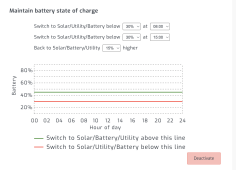jibberishballr
New Member
- Joined
- Aug 4, 2022
- Messages
- 35
I've been watching YouTube videos and searching through this forum, so if I missed something please direct me to a source of truth. I have Solar Assistant (SA) set with my 2X LV6548 inverters (Split Phase), 200a JK BMS- no additional communications to the inverter, and 16cells (EveLF280K LiFePO4 280Ah). I'm using the "emulated values" for reading in SA and running SBU as my output source priority.
Few Observations & Questions:
Appreciate the help in advance!
Few Observations & Questions:
- SOC and voltage are still a little confusing to me in the sense of which truly indicates battery life and when is the time to switch on the grid to support rather than running them too low. Solar assistant has Battery Settings which I have set based on some recommendations- still a little confused on what is optimal here, but my understanding is if you set the battery settings to lower than necessary you can utilize the "maintain battery state of charge" in the power tab rather than relying on these battery settings. Is this the right approach instead of using voltage? What would I change my battery settings to in order to best utilize the maintain SOC settings (see my current settings below)? I activated it last night (see screenshot 2) and noticed that this morning (6am) I was pulling from the grid until about 8am, then all good through the day with the battery being charged). It looks like SOC never went below 50% (see screenshot 3). Maybe someone could explain how I should use this setting in simpler terms?



- What does each of these battery settings mean (screenshot 1)? Some seem self explanatory but I couldn't find the documentation that spells them out from SA.
- I noticed that I can change one of my inverters (#1) to set "solar only" but when i switch to inverter #2 the option isn't editable and stuck on "solar first." Any ideas? I think it may be because the inverter is read from a parallel connection but not sure...
- What are the min and max SOC I should see? Is it okay that I am 100% SOC during the day with battery kicking in after sun hours? What about how low SOC I should allow it to get down to? Want to ensure longevity of the batteries and utilize that "maintain battery state of charge" to the right %s (see screenshot 2).
- Not as important but still curious as I set my kwH for the emulated values setting...I understand kWh = Ah × V/1,000. What voltage should I be using to make that calculation? If the cells are 3.2 and I have 16, then would it be (16x3.2)=51.2 meaning 280x51.2/1000=14.34 Kwh?
Appreciate the help in advance!
Last edited:


